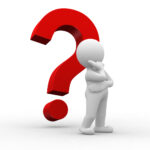Question No. 1
In which part of the steam turbine does stress corrosion cracking (SCC) occur?
Answer:
In the wet stages of the low-pressure turbine.
Question No. 2
In which zone of steam turbines has temperature-creep rupture been observed?
Answer:
Damage due to creep is encountered in high temperature (exceeding 455°C) zones. That is, it has been found to occur in the control stages of the high-pressure and intermediate-pressure turbines where steam temperature sometimes exceed 540°C. In the reheat stage, it has been observed that creep has caused complete lifting of the blade shroud bands.
Question No. 3
What are the types of thrust bearings?
Answer:
1. Babbitt-faced collar bearings
2. Tilting pivotal pads
3. Tapered land bearings
4. Rolling-contact (roller or ball) bearings
Question No. 4
What are the types of turbine seals?
Answer:
1. Carbon rings fitted in segments around the shaft and held together by garter or retainer springs.
2. Labyrinths mated with shaft serrations or shaft seal strips.
3. Water seals where a shaft runner acts as a pump to create a ring of water around the shaft. Use only treated water to avoid shaft pitting.
4. Stuffing box using woven or soft packing rings that are compressed with a gland to prevent leakage along the shaft.
Question No. 5
What are the basic causes of the problem of rotor failure?
Answer:
(A) Normal wear.
(B) Fatigue failure due to high stress.
(C) Design deficiency.
(D) Aggressive operating environment
Question No. 6
What are the differences between impulse and reaction turbines?
Answer:
1. The impulse turbine is characterized by the fact that it requires nozzles and that the pressures drop of steam takes place in the nozzles.
2. The reaction turbine, unlike the impulse turbines has no nozzles, as such. It consists of a row of blades mounted on a drum. The drum blades are separated by rows of fixed blades mounted in the turbine casing. These fixed blades serve as nozzles as well as the means of correcting the direction of steam onto the moving blades.
3. In the case of reaction turbines, the pressure drop of steam takes place over the blades. This pressure drop produces a reaction and hence causes the motion of the rotor.
Question No. 7
What is the function of EGR VALVE?
Answer:
EGR means Exhaust Gas Recirculation. The main function of EGR is to control NOx emission from the engine. At elevated temperature (during long run & full condition)if due to some reasons engine gets heated up beyond certain level… it produces NOx emission. In order to avoid this pollution, we have to control the temperature rise inside the cylinder. This can be achieved by mixing some amount of exhaust gas with intake air. By doing this the temperature inside the combustion chamber is reduced. And NOx is controlled.
Question No. 8
What is the difference between Critical speed & Whirling speed?
Answer:
In Solid mechanics, in the field of rotor dynamics, the critical speed is the theoretical angular velocity which excites the natural frequency of a rotating object, such as a shaft, propeller or gear. As the speed of rotation approaches the objects natural frequency, the object begins to resonate which dramatically increases system vibration. The resulting resonance occurs regardless of orientation.
Whirling Speed is due to the unbalanced forces acting on a rotating shaft.
Question No. 9
What is specific speed of turbine?
Answer:
The specific speed is defined as the speed of the geometric turbine which can produce unit power at unit head
Question No. 10
Material of Aircraft turbine blades
Answer: Ni, Cr, Al, Traces of C


